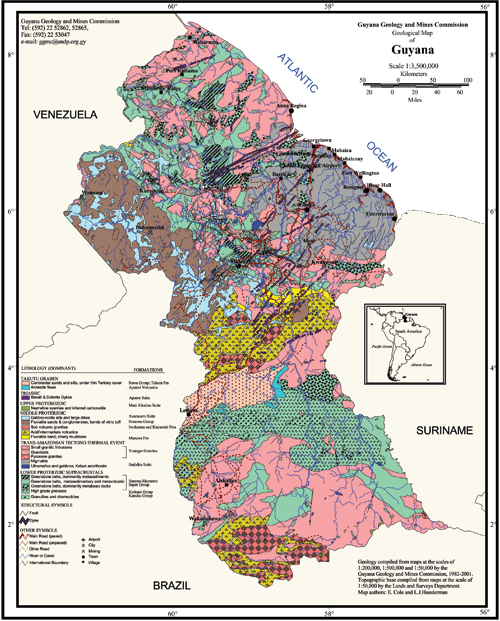The Guiana Shield, comprising Guyana, Suriname , French Guiana, as well as parts of Colombia, Venezuela and Brazil has been described as a vast ensemble of supracrustal rocks composed of greenstone belts and granite surrounded by the flat Tertiary and Quaternary deposits of millions of years ago. In Guyana granite is ubiquitous; is everywhere.
It is easily recognisable as materials for construction of buildings, for sea defence, for road building and other construction purposes.
Quarrying is a major economic activity.
Granite is an igneous rock having been formed from the melting of sedimentary and volcanic rocks.
Collisions of two of the plates that make up the crust of the Earth (tectonic plates) were responsible for generating the molten continental crust materials forming magma that cooled to form granite.
The emplacement or intrusion of the granitic rocks in Guyana took place during the Trans-Amazonian Tectonothermal Episode (TATE) an orogeny in the Lower Proterozoic between 2.1 and 1.9 billion years ago.
When magma solidifies within the crust the resulting rocks are called intrusive or plutonic rocks and so granite is usually referred to as an intrusive or plutonic rock.
Subsequent erosion over millions of years exposed the extremely hard granitic rocks at the surface of the earth.
There are large complexes of granite in both the Northern and Southern provinces of Guyana.
The Northern Guyana Granite Complex brings to mind the granites of the Bartica Assemblage plus the granites which intrude the Barama-Mazaruni greenstone which are called Younger Granites.
The Younger Granites, so called to differentiate them from the older granites in the southern province, include those in the Kurupung-Putareng Complex, the Aranka-Wenamu Complex, the Aurora Complex and the Morabisi Complex among others.(Gibbs and Barron, 1993).
The Bartica Assemblage consists of a varied suite of gneisses (metamorphosed igneous rocks) and amphibolites ( a major metamorphic rock type) on the northern margin of the Guiana shield, occupying more than 5,000 square miles.
There, the largest outcrop of granite is the great mass extending from Makouria Point on the Essequibo to the south-end of Karia Island on the Mazaruni, and to the foot of Akaio Rapid on the Cuyuni.
Similar granites, but of more gneissose (metamorphosed) structure, occur at Granite Island at Canayaballi on the Waini river on the divide between the Barama and Waini rivers, and on the Pomeroon river.
Outcrops also occur on the Demerara and Corentyne rivers but are smaller in extent.
The rock groups in the Bartica Assemblage are well exposed in the region of Bartica.
In 1968 a visiting geologist named Schiele estimated that there was over twenty million tons of quarriable material available in the Bartica Assemblage above sea level and two to three times this amount below sea level.
The granite there has been quarried since the late 1950s early 1960s with the four main quarries being St. Mary’s Quarry on the Essequibo , owned and operated by Toolsie Persaud Limited, the Monkey Jump Quarry along the Essequibo river and the Big Hope Quarry along the Mazaruni River both operated by Barakara Quarries, and B.K. Quarries formerly Mazaruni Granite Products.
The rocks are extracted and crushed and are used for road and building foundations and sea defence construction.
With respect to the Younger Granites, Kurupung and Putareng are both batholiths, a batholith being a very large intrusive granitic rock mass that has been formed beneath the Earth’s surface by the intrusion and solidification of magma and that has been exposed by erosion and has an exposed surface area of over 38 square miles.
The Kurupung-Putareng granitic complex in Region 7 Cuyuni/Mazaruni)covers an area of 772 square miles in the Mazaruni Greenstone belt and is associated with gold and diamond mining.
The Aurora Granitic Complex on the Cuyuni covers an area of 250 square miles .
This is another area which is adjacent to greenstone belts and hosts large gold deposits.
Exploratory drilling by Guyana Goldfields Inc proves that gold mining operations at Aurora will be larger than Omai.
The Aranka-Wenamu granitic complex in Region 1 (Barama/Waini) covers over 500 square miles.
Makarapan granite is a mountain of granite located near Annai, Rupununi just north of the Takutu Graben.
This massif has been radio-isotopically dated at 2.39 billion years old
and represents one of the oldest formations in the Guiana Shield .
And there are many such other mountains particularly in the Southern province.
The lower Proterozoic TATE which created these granitic bodies was followed by two other compressional episodes, namely a reactivation of the TATE around 1.8 billion years ago and the Nickerian episode between 1.1 and 1.3 billion years ago.
The reactivation period of the Trans Amazonian orogeny, at approximately 1.8 billion years ago led to the formation of the Essequibo-Corentyne granite complexes.
It has been said that after this period the granite of the Guiana Shield had become so hardened and consolidated that it could no longer be affected by tectonic plate activities such as those that occurred during the deformation events of 2.1 and 1.8 billion years ago.



.jpg)












